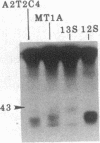Abstract
Mammalian cells transformed by nononcogenic human adenoviruses exhibit high susceptibility to destruction by host mononuclear inflammatory cells. We have analyzed the viral gene regulation of the susceptibility of transformed cells to lysis by natural killer cells and activated macrophages. Comparisons of target cell lines transformed by overlapping segments of the adenovirus E1-transforming gene region revealed that isolated expression of a single oncogene, E1A, was sufficient to cause increased cytolytic susceptibility in the absence of detectable transformed cell-surface expression of viral transplantation antigens and irrespective of histocompatibility antigen identity between killer cells and target cells. These results suggest that oncogene functions that are not linked to the expression of previously recognized cell-surface target structures may actively induce neoplastic cell elimination by components of the host immune surveillance system.
Full text
PDF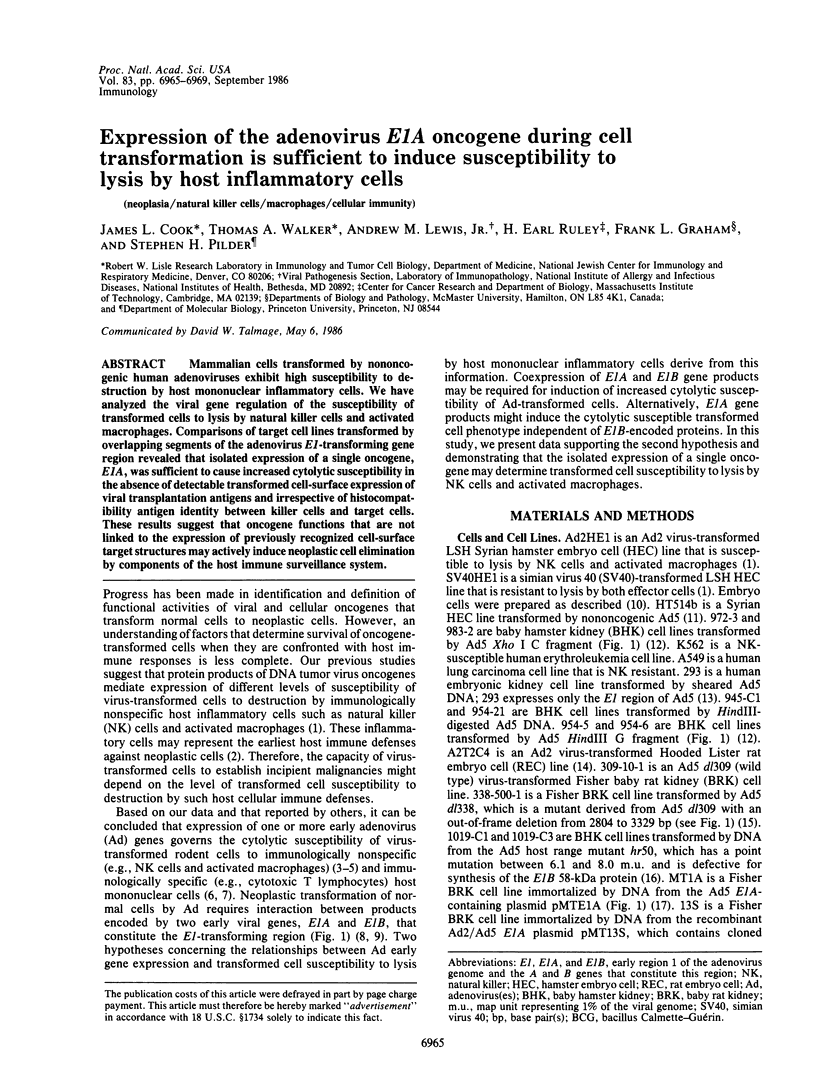
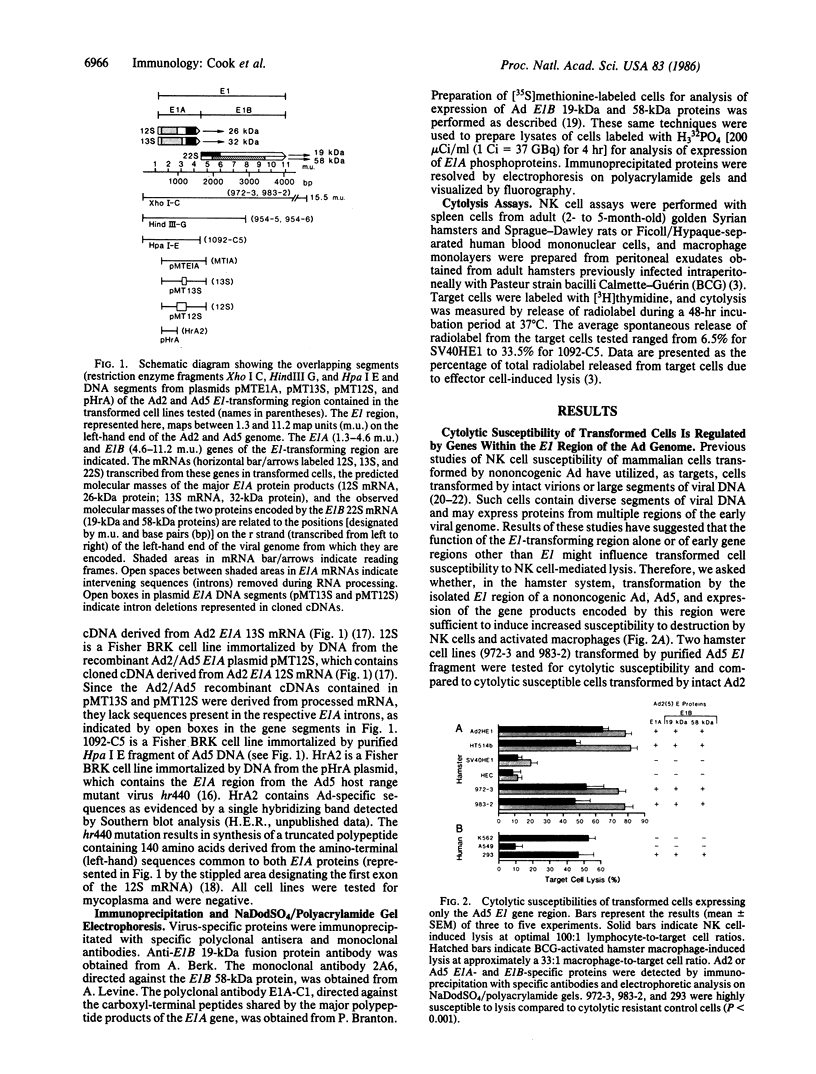
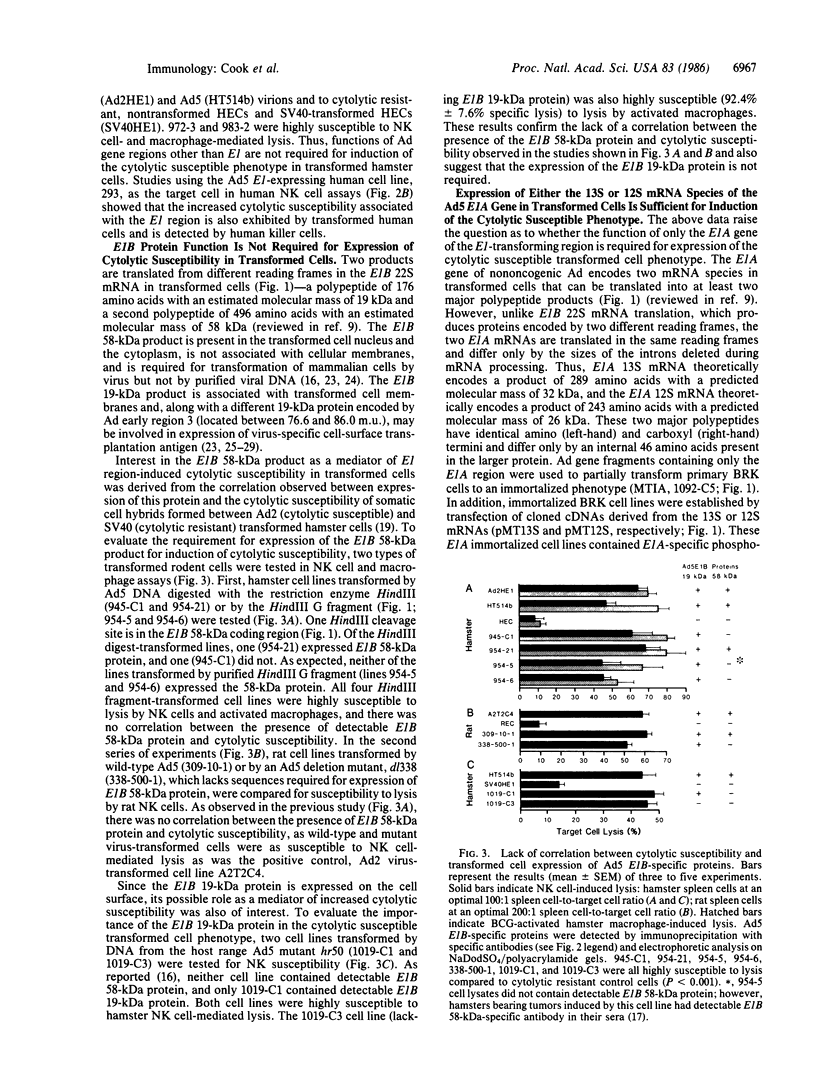
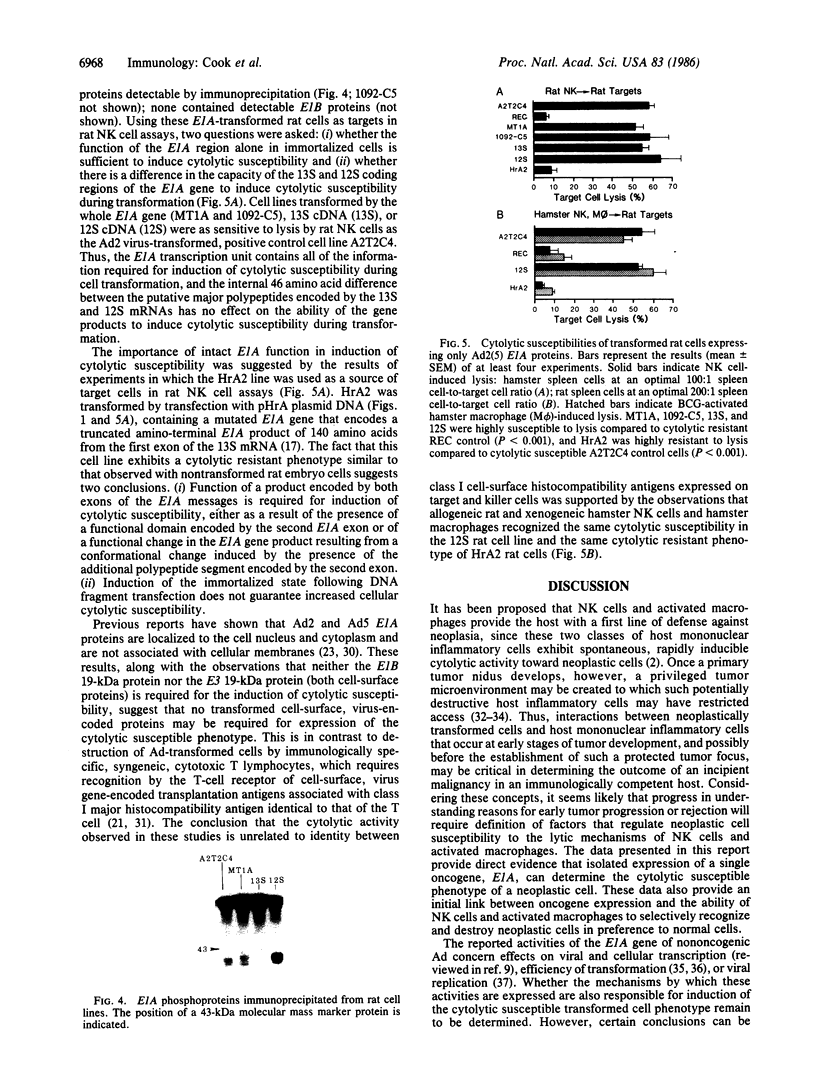

Images in this article
Selected References
These references are in PubMed. This may not be the complete list of references from this article.
- Akagi K., Patch C. T., Cook J. L., Kato T., Lewis A. M., Jr, Levine A. S. The level of expression of adenovirus type 2 transforming genes governs sensitivity to nonspecific immune cytolysis and other phenotypic properties of adenovirus 2-simian virus 40-transformed cell hybrids. Mol Cell Biol. 1985 Aug;5(8):1870–1877. doi: 10.1128/mcb.5.8.1870. [DOI] [PMC free article] [PubMed] [Google Scholar]
- Bernards R., Schrier P. I., Houweling A., Bos J. L., van der Eb A. J., Zijlstra M., Melief C. J. Tumorigenicity of cells transformed by adenovirus type 12 by evasion of T-cell immunity. 1983 Oct 27-Nov 2Nature. 305(5937):776–779. doi: 10.1038/305776a0. [DOI] [PubMed] [Google Scholar]
- Cohn M. The T-cell receptor mediating restrictive recognition of antigen. Cell. 1983 Jul;33(3):657–669. doi: 10.1016/0092-8674(83)90009-0. [DOI] [PubMed] [Google Scholar]
- Cook J. L., Hauser J., Patch C. T., Lewis A. M., Jr, Levine A. S. Adenovirus 2 early gene expression promotes susceptibility to effector cell lysis of hybrids formed between hamster cells transformed by adenovirus 2 and simian virus 40. Proc Natl Acad Sci U S A. 1983 Oct;80(19):5995–5999. doi: 10.1073/pnas.80.19.5995. [DOI] [PMC free article] [PubMed] [Google Scholar]
- Cook J. L., Hibbs J. B., Jr, Lewis A. M., Jr DNA virus-transformed hamster cell--host effector cell interactions: level of resistance to cytolysis correlated with tumorigenicity. Int J Cancer. 1982 Dec 15;30(6):795–803. doi: 10.1002/ijc.2910300619. [DOI] [PubMed] [Google Scholar]
- Cook J. L., Lewis A. M., Jr Differential NK cell and macrophage killing of hamster cells infected with nononcogenic or oncogenic adenovirus. Science. 1984 May 11;224(4649):612–615. doi: 10.1126/science.6710160. [DOI] [PubMed] [Google Scholar]
- Cook J. L., Lewis A. M., Jr Host response to adenovirus 2-transformed hamster embryo cells. Cancer Res. 1979 May;39(5):1455–1461. [PubMed] [Google Scholar]
- Fauve R. M., Hevin B., Jacob H., Gaillard J. A., Jacob F. Antiinflammatory effects of murine malignant cells. Proc Natl Acad Sci U S A. 1974 Oct;71(10):4052–4056. doi: 10.1073/pnas.71.10.4052. [DOI] [PMC free article] [PubMed] [Google Scholar]
- Föhring B., Gallimore P. H., Mellow G. H., Raska K., Jr Adenovirus type 12 specific cell surface antigen in transformed cells is a product of the E1b early region. Virology. 1983 Dec;131(2):463–472. doi: 10.1016/0042-6822(83)90512-3. [DOI] [PubMed] [Google Scholar]
- Gallimore P. H. Interactions of adenovirus type 2 with rat embryo cells. Permissiveness, transformation and in vitro characteristics of adenovirus transformed rat embryo cells. J Gen Virol. 1974 Nov;25(2):263–273. doi: 10.1099/0022-1317-25-2-263. [DOI] [PubMed] [Google Scholar]
- Graham F. L., Smiley J., Russell W. C., Nairn R. Characteristics of a human cell line transformed by DNA from human adenovirus type 5. J Gen Virol. 1977 Jul;36(1):59–74. doi: 10.1099/0022-1317-36-1-59. [DOI] [PubMed] [Google Scholar]
- Grand R. J., Gallimore P. H. Adenovirus type 12 early region 1 proteins: a study of their subcellular localization and protein-protein interactions. J Gen Virol. 1984 Dec;65(Pt 12):2149–2166. doi: 10.1099/0022-1317-65-12-2149. [DOI] [PubMed] [Google Scholar]
- Granger D. L., Taintor R. R., Cook J. L., Hibbs J. B., Jr Injury of neoplastic cells by murine macrophages leads to inhibition of mitochondrial respiration. J Clin Invest. 1980 Feb;65(2):357–370. doi: 10.1172/JCI109679. [DOI] [PMC free article] [PubMed] [Google Scholar]
- Herberman R. B., Ortaldo J. R. Natural killer cells: their roles in defenses against disease. Science. 1981 Oct 2;214(4516):24–30. doi: 10.1126/science.7025208. [DOI] [PubMed] [Google Scholar]
- Hurwitz D. R., Chinnadurai G. Immortalization of rat embryo fibroblasts by an adenovirus 2 mutant expressing a single functional E1a protein. J Virol. 1985 May;54(2):358–363. doi: 10.1128/jvi.54.2.358-363.1985. [DOI] [PMC free article] [PubMed] [Google Scholar]
- Krippl B., Ferguson B., Rosenberg M., Westphal H. Functions of purified E1A protein microinjected into mammalian cells. Proc Natl Acad Sci U S A. 1984 Nov;81(22):6988–6992. doi: 10.1073/pnas.81.22.6988. [DOI] [PMC free article] [PubMed] [Google Scholar]
- Kvist S., Ostberg L., Persson H., Philipson L., Peterson P. A. Molecular association between transplantation antigens and cell surface antigen in adenovirus-transformed cell line. Proc Natl Acad Sci U S A. 1978 Nov;75(11):5674–5678. doi: 10.1073/pnas.75.11.5674. [DOI] [PMC free article] [PubMed] [Google Scholar]
- Lewis A. M., Jr, Cook J. L. A new role for DNA virus early proteins in viral carcinogenesis. Science. 1985 Jan 4;227(4682):15–20. doi: 10.1126/science.3843807. [DOI] [PubMed] [Google Scholar]
- MAHONEY M. J., LEIGHTON J. The inflammatory response to a foreign body within transplantable tumors. Cancer Res. 1962 Apr;22:334–338. [PubMed] [Google Scholar]
- Mellow G. H., Föhring B., Dougherty J., Gallimore P. H., Raska K., Jr Tumorigenicity of adenovirus-transformed rat cells and expression of class I major histocompatibility antigen. Virology. 1984 Apr 30;134(2):460–465. doi: 10.1016/0042-6822(84)90313-1. [DOI] [PubMed] [Google Scholar]
- Montell C., Courtois G., Eng C., Berk A. Complete transformation by adenovirus 2 requires both E1A proteins. Cell. 1984 Apr;36(4):951–961. doi: 10.1016/0092-8674(84)90045-x. [DOI] [PubMed] [Google Scholar]
- Persson H., Katze M. G., Philipson L. Purification of a native membrane-associated adenovirus tumor antigen. J Virol. 1982 Jun;42(3):905–917. doi: 10.1128/jvi.42.3.905-917.1982. [DOI] [PMC free article] [PubMed] [Google Scholar]
- Pilder S., Moore M., Logan J., Shenk T. The adenovirus E1B-55K transforming polypeptide modulates transport or cytoplasmic stabilization of viral and host cell mRNAs. Mol Cell Biol. 1986 Feb;6(2):470–476. doi: 10.1128/mcb.6.2.470. [DOI] [PMC free article] [PubMed] [Google Scholar]
- Raska K., Jr, Dougherty J., Gallimore P. H. Product of adenovirus type 2 early gene block E1 in transformed cells elicits cytolytic response in syngeneic rats. Virology. 1982 Mar;117(2):530–535. doi: 10.1016/0042-6822(82)90495-0. [DOI] [PubMed] [Google Scholar]
- Raska K., Jr, Dougherty J., Gallimore P. H. Product of adenovirus type 2 early gene block E1 in transformed cells elicits cytolytic response in syngeneic rats. Virology. 1982 Mar;117(2):530–535. doi: 10.1016/0042-6822(82)90495-0. [DOI] [PubMed] [Google Scholar]
- Raska K., Jr, Gallimore P. H. An inverse relation of the oncogenic potential of adenovirus-transformed cells and their sensitivity to killing by syngeneic natural killer cells. Virology. 1982 Nov;123(1):8–18. doi: 10.1016/0042-6822(82)90290-2. [DOI] [PubMed] [Google Scholar]
- Rowe D. T., Branton P. E., Yee S. P., Bacchetti S., Graham F. L. Establishment and characterization of hamster cell lines transformed by restriction endonuclease fragments of adenovirus 5. J Virol. 1984 Jan;49(1):162–170. doi: 10.1128/jvi.49.1.162-170.1984. [DOI] [PMC free article] [PubMed] [Google Scholar]
- Rowe D. T., Graham F. L., Branton P. E. Intracellular localization of adenovirus type 5 tumor antigens in productively infected cells. Virology. 1983 Sep;129(2):456–468. doi: 10.1016/0042-6822(83)90183-6. [DOI] [PubMed] [Google Scholar]
- Rowe D. T., Graham F. L. Transformation of rodent cells by DNA extracted from transformation-defective adenovirus mutants. J Virol. 1983 Jun;46(3):1039–1044. doi: 10.1128/jvi.46.3.1039-1044.1983. [DOI] [PMC free article] [PubMed] [Google Scholar]
- Sawada Y., Föhring B., Shenk T. E., Raska K., Jr Tumorigenicity of adenovirus-transformed cells: region E1A of adenovirus 12 confers resistance to natural killer cells. Virology. 1985 Dec;147(2):413–421. doi: 10.1016/0042-6822(85)90143-6. [DOI] [PubMed] [Google Scholar]
- Sheil J. M., Gallimore P. H., Zimmer S. G., Sopori M. L. Susceptibility of Adenovirus 2-transformed rat cell lines to natural killer (NK) cells: direct correlation between NK resistance and in vivo tumorigenesis. J Immunol. 1984 Mar;132(3):1578–1582. [PubMed] [Google Scholar]
- Shiroki K., Shimojo H., Maeta Y., Hamada C. Tumor-specific transplantation and surface antigen in cells transformed by the adenovirus 12 DNA fragments. Virology. 1979 Nov;99(1):188–191. doi: 10.1016/0042-6822(79)90053-9. [DOI] [PubMed] [Google Scholar]
- Solnick D. An adenovirus mutant defective in splicing RNA from early region 1A. Nature. 1981 Jun 11;291(5815):508–510. doi: 10.1038/291508a0. [DOI] [PubMed] [Google Scholar]
- Spindler K. R., Eng C. Y., Berk A. J. An adenovirus early region 1A protein is required for maximal viral DNA replication in growth-arrested human cells. J Virol. 1985 Mar;53(3):742–750. doi: 10.1128/jvi.53.3.742-750.1985. [DOI] [PMC free article] [PubMed] [Google Scholar]
- Spitalny G. L., North R. J. Subversion of host defense mechanisms by malignant tumors: an established tumor as a privileged site for bacterial growth. J Exp Med. 1977 May 1;145(5):1264–1277. doi: 10.1084/jem.145.5.1264. [DOI] [PMC free article] [PubMed] [Google Scholar]
- Williams J. F. Oncogenic transformation of hamster embryo cells in vitro by adenovirus type 5. Nature. 1973 May 18;243(5403):162–163. doi: 10.1038/243162a0. [DOI] [PubMed] [Google Scholar]
- Zerler B., Moran B., Maruyama K., Moomaw J., Grodzicker T., Ruley H. E. Adenovirus E1A coding sequences that enable ras and pmt oncogenes to transform cultured primary cells. Mol Cell Biol. 1986 Mar;6(3):887–899. doi: 10.1128/mcb.6.3.887. [DOI] [PMC free article] [PubMed] [Google Scholar]



